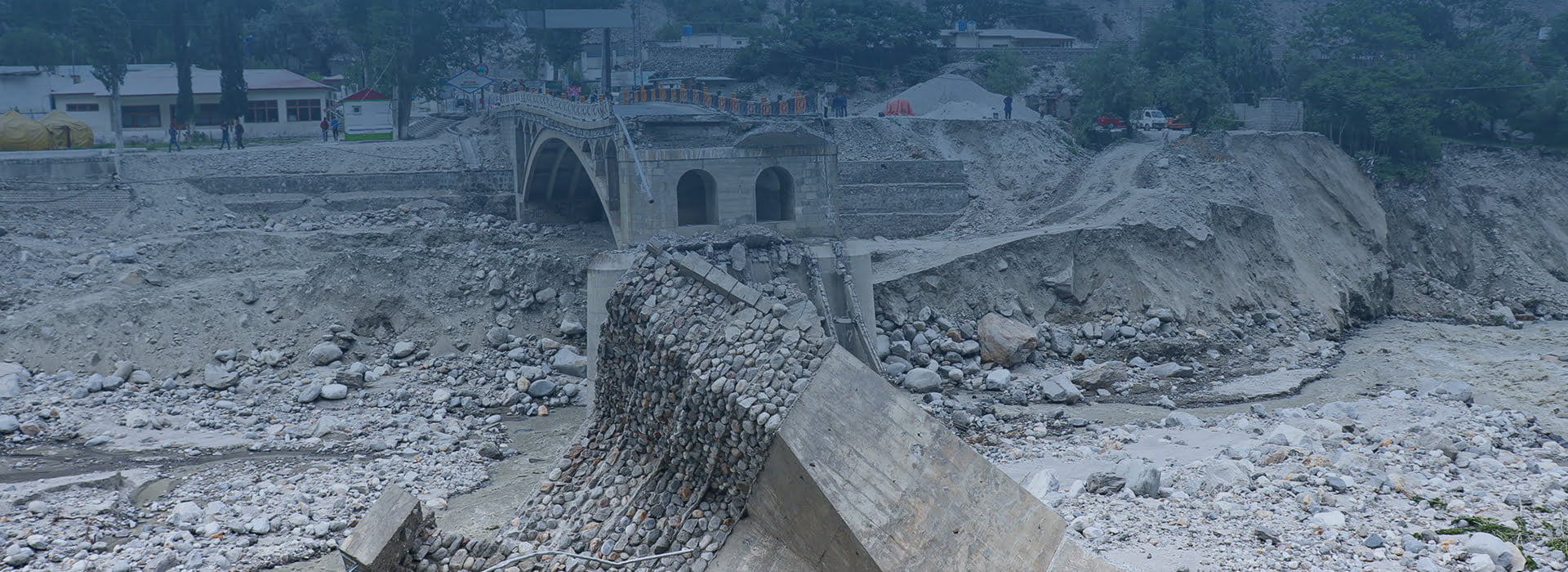 Climate Change has become one of the most significant contemporary environmental hazards, resulting in various natural disasters. The Global Climate Risk Index (CRI) 2020 report, which analyses to what extent countries and regions have been affected by the impacts of weather-related loss events (storms, floods, heat waves, etc.), reflects Pakistan as the 5th most vulnerable country to Climate Change.
Climate Change has become one of the most significant contemporary environmental hazards, resulting in various natural disasters. The Global Climate Risk Index (CRI) 2020 report, which analyses to what extent countries and regions have been affected by the impacts of weather-related loss events (storms, floods, heat waves, etc.), reflects Pakistan as the 5th most vulnerable country to Climate Change.
In the last few decades, Climate Change has emerged as an important driving force behind floods in Pakistan, primarily by affecting glacier melting and summer monsoon patterns. The average temperatures are increasing, rains are becoming erratic, and flash floods have become a norm. Floods pose the most significant threat to lives and livelihoods. Besides the noticeable impact on infrastructure and utilities, flooding is a potential indicator of many long-term effects, including economic losses, loss of means of livelihood, ecological changes, and public health challenges.
For several years, Untimely rainfalls have damaged cotton and wheat crops, making farmers switch to water-intensive sugarcane. Food production is susceptible to water availability and temperature variability. Therefore, a dynamic shift toward climate-smart agricultural practices is needed if food security is to be ensured.
It is evident from the ongoing floods in Pakistan that hazard alone would not have turned into a disaster had it not intersected with conditions of vulnerability and exposure, which encompass all physical, socio-economic, and environmental factors that increase our susceptibility to hazards. The fact that the marginalized communities are suffering the most significant impacts from the floods further solidifies this notion. These communities already have limited adaptive capacity, and the impacts of Climate Change exacerbate the effect. A striking example of this can be observed in Balochistan, Sindh, and the northern region of Pakistan, where torrential rains and flashfloods have wreaked havoc.
One of the main pillars of climate adaptation and mitigation is engaging the grass root stakeholders. These include developing adaptation plans with district and tehsil level projects and re-aligning the Annual Development Plans (ADPs) with provincial and local adaptation needs. Besides adaptation, focusing on resilience is critical, opening up new investments in climate-resilient urban and rural development and attracting international climate finance. Transformational change in energy, cities, food and land use, water, and industry with private investments and climate-resilient technologies can help create a people-centered growth model. Another crucial step in Climate Change adaptation and mitigation is creating a safety net for its victims, for example, establishing an insurance or risk transfer fund.
Pakistan has a good institutional and policy framework in place. However, the problem of Climate Change and the consequent frequent flood in Pakistan requires a deeper analysis to arrive at workable solutions. Most importantly, to tackle climate-induced disasters such as floods, Pakistan needs to attract finances for climate-smart infrastructure, promote innovation and transparency, and engage with local stakeholders, including development organizations. Hashoo Foundation proactively explores the development and private role in galvanizing Pakistan’s Climate Action priorities. Aligned with the Global Sustainable Development Goals (SDGs) 2030 and Pakistan Vision 2025, the key thematic areas of the Foundation are Climate Change, Entrepreneurship and Economic Growth, and Social Sector Development. Globally, the organization supports the SDG 13 agenda as a member of the Climate Action Network South Asia (CANSA) and an observer of the United Nations Framework Convention on Climate Change (UNFCCC). Hashoo Foundation is the only South Asian civil society partner of InsuResilience Global Partnership.
One of the key components of the adaptation to Climate Change vulnerabilities is focusing on the resilience of local communities. Hashoo Foundation is one of the leading development practitioners in Environment, Climate Change, and Disaster Risk Reduction (DRR). It specializes in awareness creation and strategy development to promote renewable energy efficiency & conservation, improve environmental quality, adapt to climate variabilities, and build resilience to climate-induced disasters through youth engagement and creating an environment of resilient approaches. Hashoo Foundation has an outstanding history in designing and managing complex and large-scale climate adaptation & mitigation programs. It has a well-established implementation capacity, gained through implementing a wide range of multi-sectoral and socio-economic development programs with multiple institutional funding agencies and the Government of Pakistan. Hashoo Foundation established Pakistan’s first Sustainable Methods and Resilient Technologies (SMaRT) villages in Gilgit-Baltistan, which encompasses sustainable water resource management, food security, solid waste management, and economic empowerment. The organization has also been involved in humanitarian efforts in different Glacial Lake Outburst Flood (GLOF-II) areas.
It is believed that the already existing vulnerability may increase in regions like Pakistan, where extreme events such as floods will become more frequent or more severe due to Climate Change. Therefore, it is important to have a public discourse on Climate Change and its devastating impacts and integrate disaster risk reduction and climate resilience into sectoral policy and the national agenda. The ongoing climate-induced extreme events in Pakistan, particularly floods, require a holistic and interdisciplinary approach. Development sector organizations can provide critical technical support and guidance to the government regarding climate-resilient institutional and policy regimes, besides undertaking on-ground humanitarian and relief work.